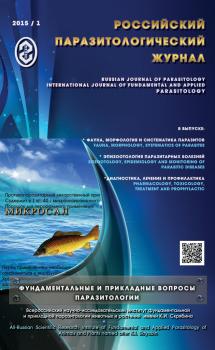Moskva, Moscow, Russian Federation
Objective of research: To study the infection rate with B. sulcata in various age groups of cattle in summer at different management technologies in the Kurgan region. Materials and methods. Samples were collected from animals kept under different management technologies (private sector, stabling&pasture, stabling) in the Kurgan region in July 2016. Samples weighing 10 g were taken from animals of different age groups from the rectum or by usual fecal gathering in animal premises. The collected material was preserved with 2% potassium dichromate. At the Laboratory for Protozoology and Sanitary Parasitology of the All-Russian Scientific Research Institute of Fundamental and Applied Parasitology of Animals and Plants named after K.I. Skryabin, 68 samples were examined under the microscope by methods of successive washings and formalinether sedimentation; cyst counting was performed in a counting chamber Mc Master. Results and discussion. The results of random coproscopic examination of cattle of different age groups in farms of the Kurgan region in summer period revealed their infection with Buxtonella sulcata. Extensity of infection in the private sector ranged from 33% to 50%, in farms with stable management — from 10 to 62,5%, stable and pasture management — from 0 to 85,7%.
cattle, diagnosis of protozooses, protozoa infection, buxtonellosis, Buxtonella sulcata.
Введение
Заболевания желудочно-кишечного тракта крупного рогатого скота актуальная проблема для животноводства и ветеринарии в связи с экономическими потерями продуктивности, а также затрат на лечение и диагностику, тем более это заметно в настоящее время, когда темпы роста отрасли стремительно увеличиваются, благодаря федеральным программам продовольственной независимости и импортозамещения.
Возбудителями кишечных протозоозов у крупного рогатого скота являются, Eimeria spp., чаще у молодняка (Красочко П.А. и др., 2003), Сryptosporidium spp.у животных с низким иммунным статусом (Никитин В.Ф., 2007).
1. Gromov B.V. Endocytobiontes of animal cells. Soros. obrazovat. zhurn. [Soros Educational Journal.], 1998, no. 2, pp. 73-78. (In Russian)
2. Krasochko P.A., Novikov O.G., Yatusevich A.I Spravochnik po naibolee rasprostranennym boleznyam krupnogo rogatogo skota i sviney [Handbook of most common diseases in cattle and swine]. Smolensk, 2003. 828 p. (In Russian)
3. Krylov M.V. Opredelitel’ paraziticheskih prostejshih: cheloveka, domashnih zhivotnyh i sel’skohozyaystvennyh rasteniy [Guide to the parasitic protozoa in humans, domestic animals and agricultural plants], 1996, Zool. Ins. RAS. 602 p. (In Russian)
4. Krylov M.V. Vozbuditeli protozoynyh bolezney domashnih zhivotnyh i cheloveka [Causative agents of protozoan diseases in domestic animals and humans]. SPb., 1994, Zool. Ins. RAS. 267 p. (In Russian)
5. Nikitin V.F. Biological and epitoozological features of cryptosporidiosis in domestic animals and its prevention. Ros. parazitol. zhurn. [Russian Journal of Parasitology], 2007, no. 1, pp.36-38 (In Russian)
6. Shibitov S.K., Safiullin, R.T. Prevalence of Buxtonella Sulcata among cattle in Central Russia. Veterinariya [Veterinary], 2016, no. 8, pp. 36-38. (In Russian)
7. Al-Saffar T.M. et al. Prevalence of intestinal ciliate B. sulcata in cattle in Mosul. Iraqi J Vet Sci., 2010, vol. 24. no. 1, pp. 27-30.
8. Fox M.T., Jacobs D.E. Patterns of infection with B. sulcata in British cattle. Research in veterinary science, 1986, vol. 41, no. 1, pp. 90-92.
9. Hong K.O., Youn H.J. [Incidence of B. sulcata from cattle in Kyonggi-do].The Korean journal of parasitology, 1995, vol. 3, no. 2, pp. 135-138.
10. Omeragić J., Crnkić Ć. Diarrhoea in cattle caused by B. sulcata in Sarajevo area Veterinaria, 2015, vol. 64, no. 2, pp. 50-54.
11. Pomajbíková K. et al. Novel insights into the genetic diversity of Balantidium and Balantidium-like cyst-forming ciliates. PLoS Negl Trop Dis., 2013, vol. 7, no. 3. pp. 2140.
12. Sultan K., Khalafalla R.E., Elseify M.A. Preliminary investigation on B. sulcata (Jameson, 1926) (Ciliophora: Trichostomatidae) in Egyptian ruminants. BS Vet Med J., 2013, vol. 22, pp. 91-94.
13. Tomczuk K. et al. Incidence and clinical aspects of colon ciliate B. sulcata infection in cattle. Bull Vet Inst Pulawy, 2005, vol. 49, no. , pp. 29-33.
14. Urman H.D., Kelley G.W.B. sulcata a ciliate associated with ulcerative colitis in a cow and prevalence of infection in Nebraska cattle. Iowa State University Veterinarian, 1963, vol. 26, no. 2, p. 11.
15. Velázquez J.B. sulcata en bovinos de Costa Rica. Ciencias Veterinarias, 1983
16. http://eol.org/





